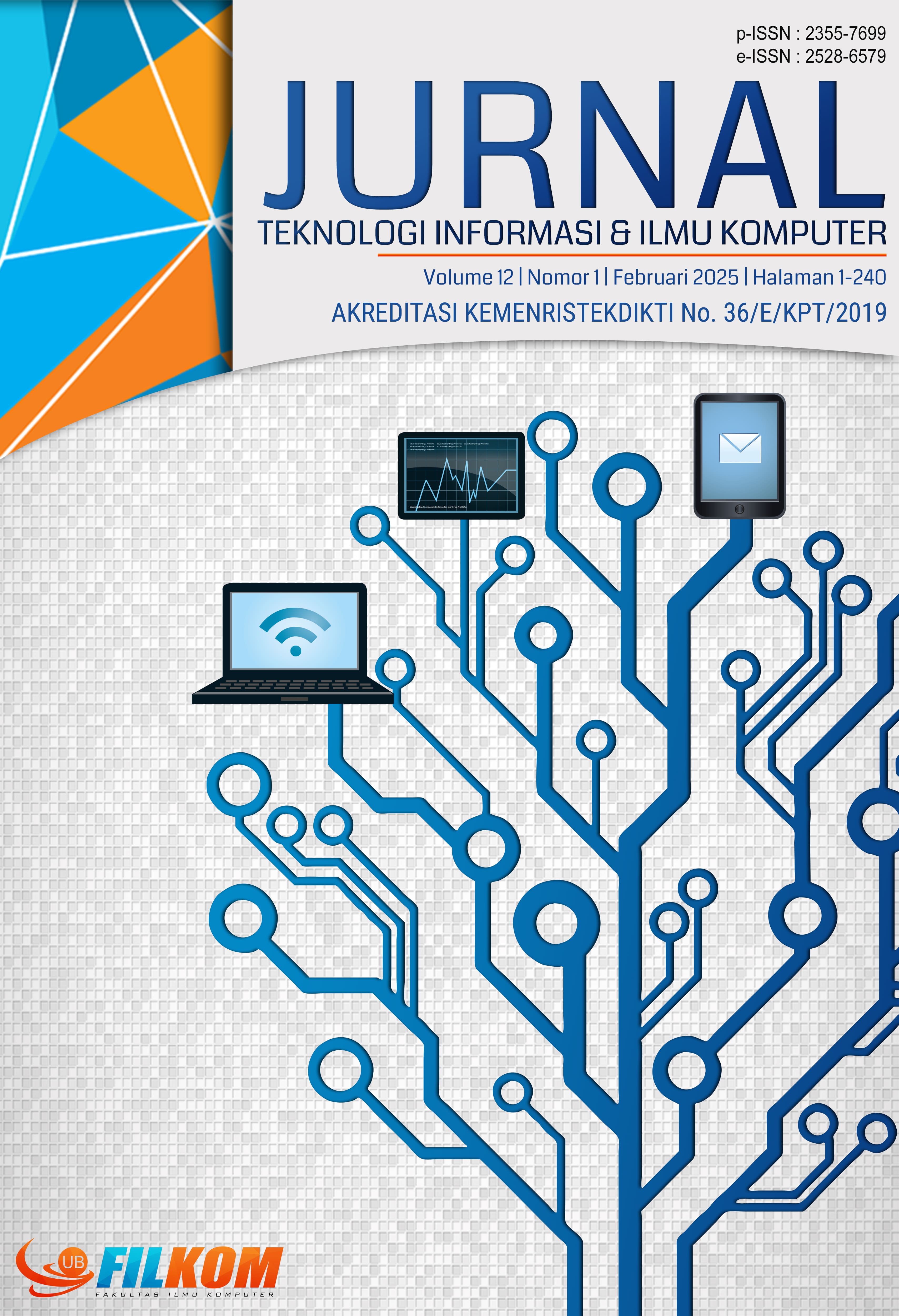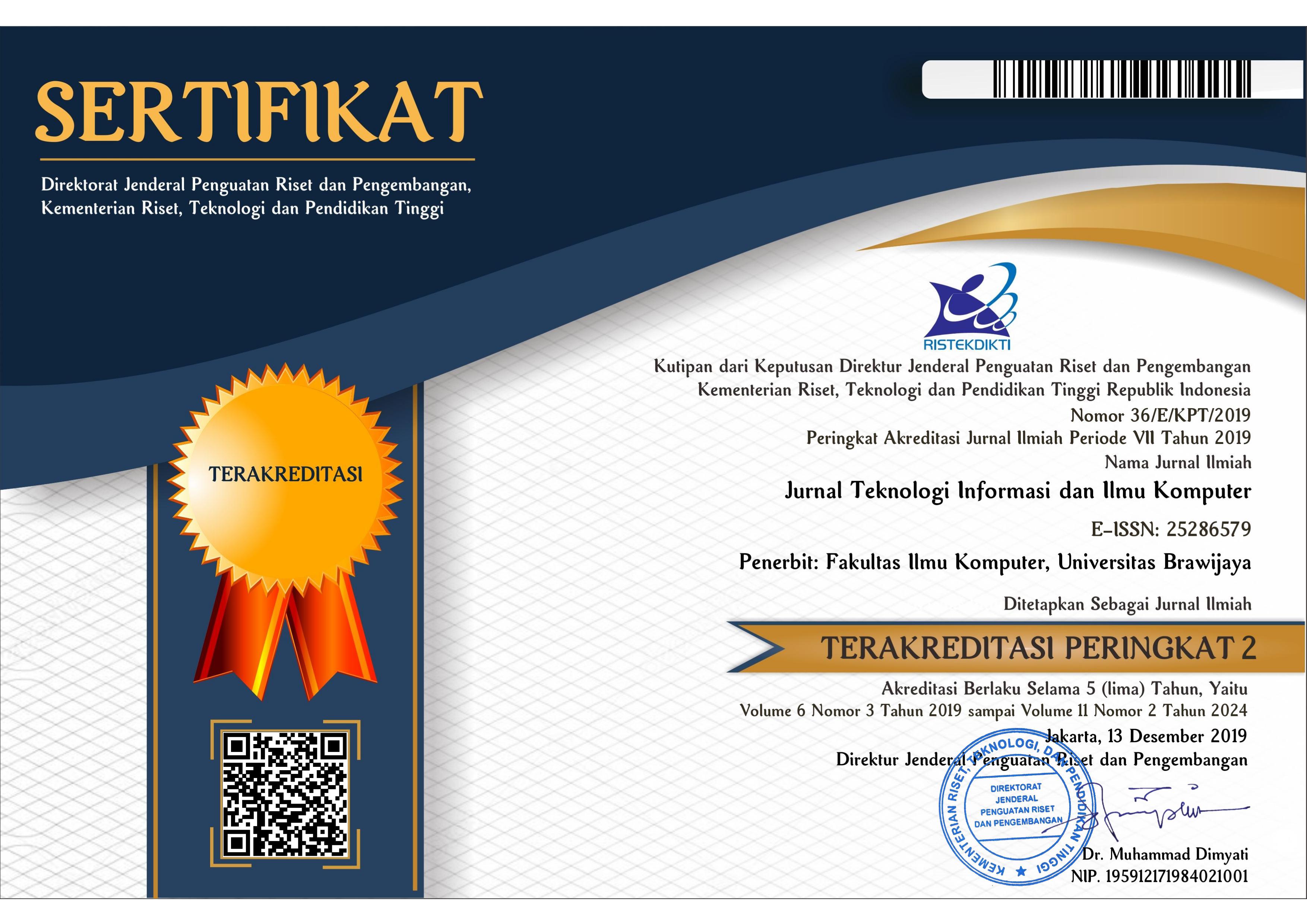Analisis Kinerja Model Deteksi Objek Yolo, Ssd, dan Faster R-Cnn pada Citra Penglihatan Malam untuk Pengenalan Tindak Kejahatan
DOI:
https://doi.org/10.25126/jtiik.2025128409Kata Kunci:
klitih, Deep Learning, YOLOv6, SSD, Faster R-CNNAbstrak
Kejahatan klitih di wilayah Yogyakarta telah menimbulkan kekhawatiran serius bagi pemerintah dan masyarakat, sehingga mengancam keamanan dan kenyamanan publik. Dalam upaya penanganan permasalahan ini, penelitian ini mengajukan solusi implementasi teknologi keamanan yang berfokus pada kamera night vision dan machine learning guna mendeteksi kejahatan klitih dengan efektif, khususnya pada rentang waktu malam. Data yang dikumpulkan untuk penelitian ini terdiri dari 1006 gambar yang direkam dari aksi kejahatan klitih. Proses pengolahan data melibatkan beberapa tahap, dimulai dengan preprocessing di mana seluruh gambar diubah ukurannya menjadi 640x640 piksel. Selanjutnya, dilakukan augmentasi data untuk meningkatkan variasi dan ketangguhan model, berupa rotasi sebesar 90°, crop dengan variasi zoom dari 0% hingga 20%, penambahan noise dilakukan hingga 5%. Hasil penelitian menunjukkan bahwa model YOLOv6 memberikan kinerja terbaik dalam mendeteksi label senjata, dengan akurasi sebesar 0,9 dan F1-score mencapai 0,91. Sementara itu, dalam mengenali kejahatan fisik, YOLOv6 juga menunjukkan performa unggul dengan akurasi 0,63 dan F1-score 0,73. Model Faster R-CNN dan SSD juga memberikan hasil yang baik, namun YOLOv6 mempertahankan dominasi dalam deteksi kejahatan klitih berdasarkan akurasi dan evaluasi metrik lainnya. Pemanfaatan teknologi pendeteksian klitih di masa depan dapat memberikan kontribusi positif dalam menciptakan lingkungan yang lebih aman dan nyaman bagi seluruh masyarakat.
Abstract
The prevalence of klitih criminal activity within the Yogyakarta region has engendered significant apprehension among governmental authorities and the public alike, thereby posing a substantial risk to community safety and well-being. In an effort to address this pressing concern, the present research advocates for the deployment of advanced security technologies, specifically emphasizing the utilization of night vision surveillance cameras in conjunction with machine learning algorithms to proficiently identify klitih-related offenses, particularly during nocturnal hours. The dataset utilized for this investigation comprises 1,006 photographic images obtained from various klitih crime occurrences. The data processing procedures encompassed multiple phases, commencing with preprocessing wherein all images were standardized to dimensions of 640x640 pixels. Subsequently, data augmentation techniques were employed to bolster the diversity and resilience of the model, incorporating transformations such as 90° rotations, cropping with zoom variations ranging from 0% to 20%, and the introduction of noise levels of up to 5%. The findings of this study indicate that the YOLOv6 model exhibited the most favorable performance in the detection of weapon classifications, achieving an accuracy rate of 0.9 and an F1-score of 0.91. Furthermore, in the context of identifying physical crimes, YOLOv6 similarly showcased outstanding efficacy, attaining an accuracy of 0.63 and an F1-score of 0.73. Although the Faster R-CNN and SSD models yielded commendable results, YOLOv6 sustained its preeminence in the realm of klitih crime detection, as evidenced by its superior accuracy and other evaluative metrics. The prospective implementation of klitih detection technology holds the potential to make a constructive impact in fostering a safer and more secure environment for the entire community.
Downloads
Referensi
ADITYA P, A., WIBOWO, S. A. AND RAHMANIA, R. 2021. Investigasi pengaruh Step Training pada Skema Same-Padding untuk Metode Faster R-CNN dalam Teknologi Augmented Reality. Jurnal Ilmiah FIFO, 12(2), p. 128. doi: 10.22441//fifo.2020.v12i2.002.
CHARLI, F. et al. 2020. Implementasi Metode Faster Region Convolutional Neural Network (Faster R-CNN) Untuk Pengenalan Jenis Burung Lovebird. Journal of Information Technology Ampera, 1(3), pp. 185–197. doi: 10.51519/journalita.volume1.isssue3.year2020.page185-197.
DOMPEIPEN, T. A. et al. 2021. Computer Vision Implementation for Detection and Counting the Number of Humans. Jurnal Teknik Informatika, 16(1), pp. 65–76. doi: 10.35793/jti.v16i1.31471.
J, N. T. AND THINAKARAN, K. 2023. Detection of Crime Scene Objects using Deep Learning Techniques’, in 2023 International Conference on Intelligent Data Communication Technologies and Internet of Things (IDCIoT). IEEE, pp. 357–361. doi: 10.1109/IDCIoT56793.2023.10053440.
JIANG, W. et al. 2022. Artificial Neural Networks and Deep Learning Techniques Applied to Radar Target Detection: A Review. Electronics, 11(1), p. 156. doi: 10.3390/electronics11010156.
KEMALA, I. & WIJAYANTO, A. W. 2021. Perbandingan Kinerja Metode Bagging dan Non-Ensemble Machine learning pada Klasifikasi Wilayah di Indonesia menurut Indeks Pembangunan Manusia. Jurnal Sistem dan Teknologi Informasi (Justin), 9(2), p. 269. doi: 10.26418/justin.v9i2.44166.
LI, C. et al. 2022. YOLOv6: A Single-Stage Object Detection Framework for Industrial Applications. arXiv preprint arXiv:2209.02976.
LI, M. et al. 2023. LFD-CD: Peripheral Blood Cells Detection Using a Lightweight Cell Detection Model with Full-Connection and Dropconnect, in, pp. 623–633. doi: 10.1007/978-3-031-46677-9_43.
LIU, W. et al. 2016. SSD : Single Shot Multibox Detector, arXiv preprint arXiv:1512.02325.
NORKOBIL SAYDIRASULOVICH, S. et al. 2023. A YOLOv6-Based Improved Fire Detection Approach for Smart City Environments. Sensors, 23(6), p. 3161. doi: 10.3390/s23063161.
PATEL, H. & UPLA, K. P. 2020. Night vision Surveillance: Object Detection using Thermal and Visible Images, in 2020 International Conference for Emerging Technology (INCET). IEEE, pp. 1–6. doi: 10.1109/INCET49848.2020.9154066.
POPESCU, D. et al. 2022. Comparative Study of Neural Networks Used in Halyomorpha Halys Detection, in 2022 30th Mediterranean Conference on Control and Automation (MED). IEEE, pp. 182–187. doi: 10.1109/MED54222.2022.9837254.
SARMINI, M., KURNIYATUTI, N. & SUKARTININGSIH, S. 2018. Klithih: Invisible Crime by Teenagers. Proceedings of the 1st International Conference on Social Sciences (ICSS 2018). Paris, France: Atlantis Press, pp. 1578–1582. doi: 10.2991/icss-18.2018.328.
SINGH, A. et al. 2021. IoT Based Weapons Detection System for Surveillance and Security Using YOLOV4. 2021 6th International Conference on Communication and Electronics Systems (ICCES). IEEE, pp. 488–493. doi: 10.1109/ICCES51350.2021.9489224.
SOCHA, R. & KOGUT, B. 2020. Urban Video Surveillance as a Tool to Improve Security in Public Spaces. Sustainability, 12(15), p. 6210. doi: 10.3390/su12156210.
SUKIRNO, S. 2018. Pencegahan klitih Melalui Pendekatan Budaya Baca Pada Siswa Di Daerah Istimewa Yogyakarta. Jurnal IPI (Ikatan Pustakawan Indonesia), 3(1), pp. 28–37.
SUSANTI, L., DAULAY, N. K. & INTAN, B. 2023. Sistem Absensi Mahasiswa Berbasis Pengenalan Wajah Menggunakan Algoritma YOLOv5. JURIKOM (Jurnal Riset Komputer), 10(2), p. 640. doi: 10.30865/jurikom.v10i2.6032.
WANG, H., WANG, W. & LIU, Y. 2020. X-YOLO: A deep learning based toolset with multiple optimization strategies for contraband detection. Proceedings of the ACM Turing Celebration Conference - China. New York, NY, USA: ACM, pp. 127–132. doi: 10.1145/3393527.3393549.
WIJANARKO, A. & GINTING, R. 2021. Kejahatan Jalanan Klitih Oleh Anak Di Yogyakarta. Recidive : Jurnal Hukum Pidana dan Penanggulangan Kejahatan, 10(1), p. 23. doi: 10.20961/recidive.v10i1.58845.
WONGVORACHAN, T., HE, S. & BULUT, O. 2023. A Comparison of Undersampling, Oversampling, and SMOTE Methods for Dealing with Imbalanced Classification in Educational Data Mining. Information, 14(1), p. 54. doi: 10.3390/info14010054.
ZHANG, Y., WIELAND, M. AND BASRAN, P. S. 2022. Unsupervised Few Shot Key Frame Extraction for Cow Teat Videos. Data, 7(5), p. 68. doi: 10.3390/data7050068.
Unduhan
Diterbitkan
Terbitan
Bagian
Lisensi
Hak Cipta (c) 2025 Jurnal Teknologi Informasi dan Ilmu Komputer

Artikel ini berlisensiCreative Commons Attribution-ShareAlike 4.0 International License.

Artikel ini berlisensi Creative Common Attribution-ShareAlike 4.0 International (CC BY-SA 4.0)
Penulis yang menerbitkan di jurnal ini menyetujui ketentuan berikut:
- Penulis menyimpan hak cipta dan memberikan jurnal hak penerbitan pertama naskah secara simultan dengan lisensi di bawah Creative Common Attribution-ShareAlike 4.0 International (CC BY-SA 4.0) yang mengizinkan orang lain untuk berbagi pekerjaan dengan sebuah pernyataan kepenulisan pekerjaan dan penerbitan awal di jurnal ini.
- Penulis bisa memasukkan ke dalam penyusunan kontraktual tambahan terpisah untuk distribusi non ekslusif versi kaya terbitan jurnal (contoh: mempostingnya ke repositori institusional atau menerbitkannya dalam sebuah buku), dengan pengakuan penerbitan awalnya di jurnal ini.
- Penulis diizinkan dan didorong untuk mem-posting karya mereka online (contoh: di repositori institusional atau di website mereka) sebelum dan selama proses penyerahan, karena dapat mengarahkan ke pertukaran produktif, seperti halnya sitiran yang lebih awal dan lebih hebat dari karya yang diterbitkan. (Lihat Efek Akses Terbuka).








